#TANA - Green Shell
Explore tagged Tumblr posts
Text
Old discord camp stuff
I was trying to locate a file I don't even know where I put and I found some old invitation art of my old object camp in discord.

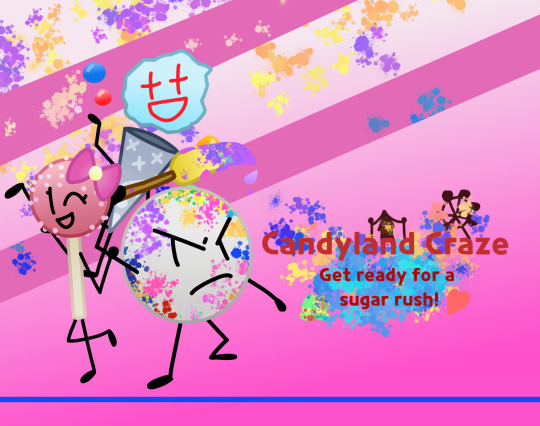

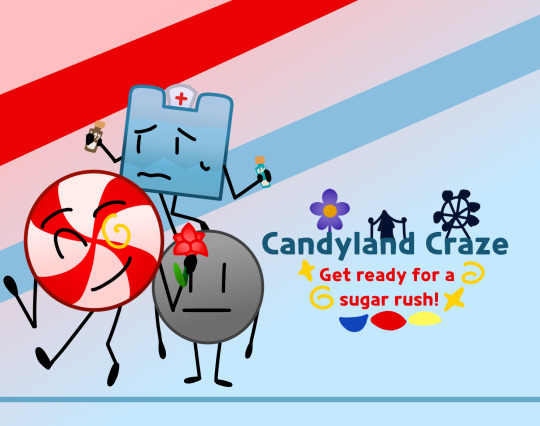




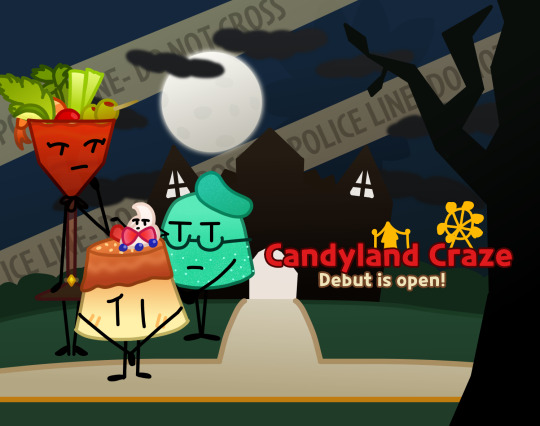



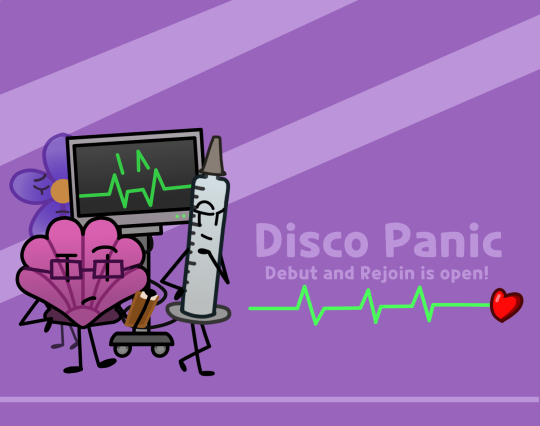
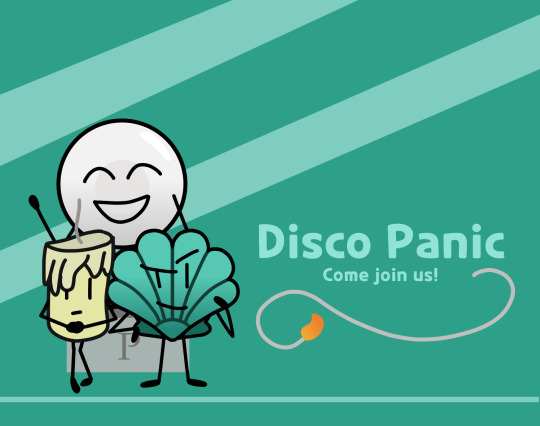

#object show community#object shows#object oc#object show oc#osc oc#osc art#tana#travel around n about#TANA - Disco Ball#TANA - Melody#TANA - Green Shell#TANA - Candle#TANA - Pearl#TANA - Purple Shell#TANA - Violet#TANA - Syringe#TANA - Holter Monitor#TANA - Lemon#TANA - Lime#TANA - Bread#TANA - Orange Shell#TANA - Popcorn#TANA - Snowcone#TANA - Cotton Candy#TANA - Cake Pop#TANA - Jawbreaker#TANA - Lemon Birthday Cake#TANA - Vanilla Cake#TANA - Pan#TANA - Pancake
14 notes
·
View notes
Text
books read in 2020
i’ve been keeping a list and decided i want it on my blog too! everything is on my goodreads too. follow my book blog @thesonofneptune! bolded are my favourites
Middlegame by Seanan McGuire ★★★★
Stardust by Neil Gaiman ★★★
Into The Drowning Deep by Mira Grant ★★★★
Heart of Flames (Crown of Feathers #2) by Nicki Pau Preto ★★★★
Reverie by Ryan La Sala ★★
Crown of Feathers (Crown of Feathers #1) by Nicki Pau Preto ★★★
Soul in Darkness by Wendy Higgins ★★★
The King’s Dragon (Fire and Valor #1) by W.M. Fawkes ★★★★
Blue on Blue by Dal Maclean ★★★★
The Calculating Stars (Lady Astronaut #1) by Mary Robinette Kowal ★★★★
The Watchmaker of Filligree Street (The Watchmaker of Filligree Street #1) by Natasha Pulley ★★★
The Lost Future of Pepperharrow (The Watchmaker of Filligree Street #2) by Natasha Pulley ★★★★
The Bedlam Stacks by Natasha Pulley ★★★
Gods of Jade and Shadow by Silvia Garcia-Moreno ★★★★
Girls of Paper and Fire (Girls of Paper and Fire #1) by Natasha Ngan ★★★
The Prince’s Dragon (Fire and Valor #2) by W.M. Fawkes ★★★★
House of Salt and Sorrows by Erin A. Craig ★
The House of Binding Thorns (Dominion of the Fallen #2) by Aliette de Bodard ★★★
The House of Sundering Flames (Dominion of the Fallen #3) by Alliette de Bodard ★★★
The City of Brass (The Daevabad Trilogy #1) by S.A. Chakraborty ★★★
The Catch Trap by Marion Zimmer Bradley ★★★★
The Ballad of Songbirds and Snakes (The Hunger Games #0) by Suzanne Collins ★★★
Of Dragons, Feasts and Murders (Dominion of the Fallen, #3.5) by Aliette de Bodard ★★★★
The Last Smile in Sunder City (The Fetch Phillips Archives #1) by Luke Arnold ★★★★
Northern Wrath (The Hanged God Trilogy #1) by Thilde Kold Holdt ★★★
The Unspoken Name (The Serpent Gates #1) by A.K. Larkwood ★★★
Infernal by Mark de Jager ★★★
The City We Became (Great Cities #1) by N.K. Jemisin ★★★
Gideon the Ninth (The Locked Tomb #1) by Tamsyn Muir ★★★
Deathless (Leningrad Diptych #1) by Catherynne M. Valente ★★★
The Poppy War (The Poppy War #1) by R.F. Kuang ★★★★★
The Dragon Republic (The Poppy War #2) by R.F. Kuang ★★★★
Foundryside (The Founders Trilogy #1) by Robert Jackson Bennett ★★★
Rivers of London (Rivers of London #1) by Ben Aaronovitch ★★★
The Pearl That Broke Its Shell by Nadia Hashimi ★★★★
The Deep by Rivers Solomon ★★★
Ashes of the Sun (Burninngblade & Silvereye #1) by Django Wexller ★★★
The Century’s Scribe (A Fantastic Decade #1) by Brendan Walsh ★★★★
Red, White & Royal Blue by Casey McQuistonn ★★★
The Four Profound Weaves by R.B. Lembergg ★★★
A Very Large Expanse of Sea by Tahereh Mafi ★★★
Blazewrath Games by Amparo Ortiz ★★★★
The House in the Cerulean Sea by T.J. Klune ★★★★
The Sword of Kaigen by M.L. Wang ★★★★★
Jade City (The Green Bone Saga #1) by Fonda Lee ★★★★
Jade War (The Green Bone Saga #2) by Fonda Lee ★★★★
The Night Tiger by Yangsze Choo ★★★
The Rage of Dragons (The Burning #1) by Evan Winter ★★★
The Goblin Emperor (The Goblin Emperor #1) by Katherine Addison ★★★
The Conductors by Nicole Glover ★★★
The Wolf of Oren-Yaro (Chronicles of the Bitch Queen #1) by K.S. Villoso ★★★
When The Moon Is Low by Nadia Hashimi ★★★
The Ten Thousand Doors of January by Alix E. Harrow ★★★
Each of Us a Desert by Mark Oshiro ★★★★
White Silence (Elizabeth Cage #1) by Jodi Taylor ★★★
The Rook (The Checquy Files #1) by Daniel O’Malley ★★★★
The Vicar and the Rake (Society of Beasts #1) by Annabelle Greene ★★★
Lava Red Feather Blue by Molly Rinngle ★★★★
The Bone Shard Daughter (The Drowning Empire #1) by Andrea Stewart ★★★★
Alif the Unseen by G. Willow Wilson ★★★
Carter & Lovecraft (Carter & Lovecraft #1) by Jonathan L. Howard ★★★
A Good Girl’s Guide to Murder (A Good Girls’ Guide to Murder #1) by Holly Jackson ★★★★
The Bear and the Nightingale (Winternight Trilogy #1) by Katherine Arden ★★★★
The Girl in the Tower (Winternight Trilogy #2) by Katherine Arden ★★★★★
The Winter of the Witch (Winternight Trilogy #3) by Katherine Arden ★★★★
The Invisible Life of Addie LaRue by V.E. Schwab ★★★
Tower of Mud and Straw by Yaroslav Barsukov ★★★
Mexican Gothic by Silvia Garcia-Moreno ★★
Every Heart a Doorway (Wayward Children #1) by Seanan McGuire ★★★
The Changeling by Victor LaValle ★★★
Ring Shout by Djeli P Clark ★★★★
The Seven Husbands of Evelyn Hugo by Taylor Jenkins Reid ★★★★
The Year of the Witching by Alexis Henderson ★★★
We Are Okay by Nina LaCour ★★★
Dead Man in a Ditch (The Fetch Phillips Archives #2) by Luke Arnold ★★★
The Nightmare Thief (The Nightmare Thief #1) by Nicole Lesperance ★★★★
A Time of Dread (Of Blood and Bone #1) by John Gwynne ★★★★
Sleeping Giants (Themis Files #1) by Sylvain Neuvel ★★★
Dry by Neal Shusterman ★★★
Black Sun (Between Earth and Sky #1) by Rebecca Roanhorse ★★★★
The Searcher by Tana French ★★★★
Ink and Bone (The Great Library #1) by Rachel Caine ★★★
The Burning God (The Poppy War #3) by R.F. Kuang ★★★★
The Drowning Faith (The Poppy War 2.5) by R.F. Kuang ★★★★
The Henna Wars by Adiba Jaigirdar ★★★
Long Bright River by Liz Moore ★★
The Devil and the Dark Water by Stuart Turton ★★★★
Smoke and Stone by Michael R. Fletcher ★★★
A Memory Called Empire (Teixcalaan #1) by Arkady Martine ★★★
In Other Lands by Sarah Rees Brennan ★★★★
Piranesi by Susanna Clarke ★★★★
The Familiars by Stacey Halls ★★
A Man Called Ove by Fredrik Backman ★★★★
Kings of Paradise (Ash and Sand #1) by Richard Neil ★★★
Red Sister (Book of the Ancestor #1) by Mark Lawrence ★★★★
The Midnight Library by Matt Haig ★★★★
The Kingdom of Back by Marie Lu ★★★
Not Even Bones (Market of Monsters #1) by Rebecca Schaeffer ★★★
Real Life by Brandon Taylor ★★★
Godshot by Chelsea Bieker ★★★
The Toymakers by Robert Dinsdale ★★★
The Humans by Matt Haig ★★★★
My Dark Vanessa by Kate Elizabeth Russell ★★★★
The Travelling Cat Chronicles by Hiro Arikawa ★★★★
A Conspiracy of Truths by Alexandra Rowland ★★★
The Empress of Salt and Fortune (The Singing Hills Cycle #1) by Nghi Vo ★★
The Survivors by Jane Harper ★★★★
The Dry (Aaron Falk #1) by Jane Harper ★★★★
The Lost Man by Jane Harper ★★★
42 notes
·
View notes
Text
Nampō Roku, Book 6 (13.3; 13.4): a Mukō-ro with the Guests Seated on the Right Side; and, a Mukō-ro with a Board on the Far Side.

13.3) Later, as [shown] here, the the guests’ seats were [moved to] the side [of the room] adjacent to the left seat, and the ro was changed to [that side]¹. With respect to everything else, there are no other differences².

[The writing on the drawing reads: tarai-mizusashi (タライ水指)³; chaire・shiri-bukura (茶入・尻ブクラ)⁴; kono kane in nare-domo, mizusashi ni te kuguri yō ni naru (此カネ陰ナレトモ水サシニテクヽリ陽ニナル)⁵; sore yue hitotsu-mono kaku no gotoki okaruru (夫ユヘ一物如此ヲカルヽ)⁶; kore Kyū no hatsu-mei nari, Jōō mo kanshin to iu-iu (コレ休ノ發明也、紹鷗モ感心ト云〻)⁷.]

13.4) On the far side [of the ro] is a board 2-sun 5-bu [wide] -- here is also the case were [the utensil mat arranged in] this way is also admissible⁸. The way the kane are distributed is the same as before⁹.
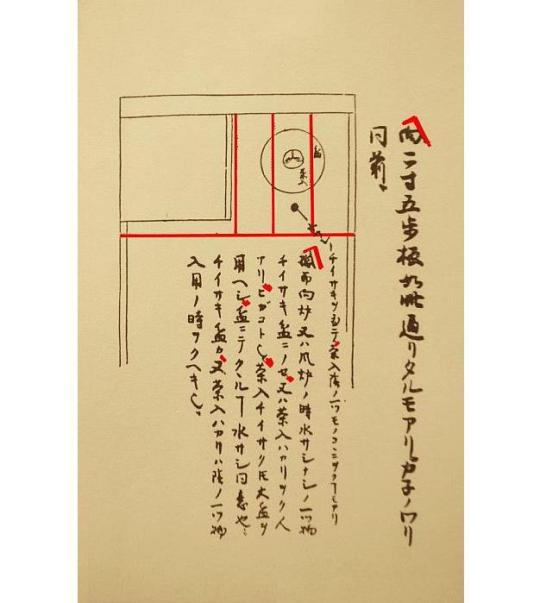
[The writing on the drawing reads: bon・chaire (盆・茶入)¹⁰; mizusashi no chiisaki wo oite, chaire in no hitotsu-mono koko ni oku-koto mo ari (水サシノチイサキヲ置テ、茶入陰ノ一ツモノコヽニヲクコトモアリ)¹¹.]
The kaki-ire [書入]:
〇 In general, in the case of the mukō-ro, or on an occasion when [one is using] the furo, even though there are people who [display the chaire] on a small tray as a [yang] hitotsu-mono, or place the chaire by itself [without a tray], these are wrong¹². Even if the chaire is a small piece, one should use a large tray¹³. If the tray crosses several kane, it is the same idea as when the mizusashi [does so]¹⁴.
[However,] using a small tray, or displaying the chaire by itself, should be done [only] when displaying [the chaire] as a yin hitotsu-mono [一ツ物]¹⁵.
_________________________
¹Nochi kaku no gotoku kyaku-tsuki hidari-za ni ro wo naosaruru [後如此客付左座ニ爐ヲナヲ��ルヽ].
Nochi [後] means afterward, at a later date.
In other words, the setting where the guests were seated on the host's left (adjoining the “right seat,” and where the mukō-ro was cut on the left side of the utensil mat) was the original configuration*. Only later was the room reversed, so that the guests sat on the host's right side (adjacent to the “left seat”), and the mukō-ro was cut on the right side of the utensil mat.
Kyaku-tsuki hidari-za ni ro wo naosaruru [客付き左座に爐を直さるる]: kyaku-tsuki [客付き] means the side (of the utensil mat) on which the guests are seated; hidari-za [左座] refers to the seat of the utensils at the head of the utensil mat, this expression referring the half of the mat facing the host's right side; naosareru [直される] (to use the modern verb form) means to be reformed, corrected, or adjusted.
Thus, this says that the ro was moved to the left seat, which was the side on which the guests were now being seated. This is the configuration that we usually recognize today†. __________ *This orientation derived directly from the o-chanoyu-dana, which was usually located on the right side of the room, originally so that the bowls of tea could be handed to an attendant seated between the mat to which the tana was appended and the entrance to the shoin, who then transported them to the guests seated in the shoin.
At some point -- very possibly in the early sixteenth century in Korea, after the restoration of Buddhism -- rather than carrying the tea out to the shoin to be drunk, or performing the temae at a daisu that was set up within that room, the custom arose whereby the guests went into the tsugi-no-ma, and were served directly from the o-chanoyu-dana.
The reason why I propose that this shift in focus (to the o-chanoyu-dana in the tsugi-no-ma) occurred in Korea (rather than in Japan) is that, when Buddhism was suppressed in Korea in the middle of the fifteenth century, the bronze implements that were used on the daisu are recorded to have been confiscated (and melted down to make ceremonial objects for use in Confucian rituals), while the iron things originally used on the o-chanoyu-dana were apparently ignored (even if left in situ when the temple buildings were razed, usually by burning, iron implements would frequently survive, at least for a certain number of years, whereas anything made of bronze would have been destroyed by the heat). It, therefore, seems that this all happened of necessity: lacking any other way to resume service with the daisu, they made use of what implements they had, and so served tea from the o-chanoyu-dana (or, when that could not be restored, changed to serving sen-cha [煎茶] -- as is also attested in the historical records, including later in the Nampō Roku).
Rikyū would have encountered this kind of thing during his sojourn on the continent, and thus he asserted that the original setting was the mukō-ro -- even though none of this seems to have been done in Japan (since, other than the Ikkō Shū [一向宗] -- and that only to a limited extent -- none of the temples were destroyed, many of these treasures still survive today).
†As has been mentioned before, this reversal of the orientation of the room was effected at the behest of Hideyoshi, so that everything that the host was doing would be readily visible to the shōkyaku (namely, himself). The Tokugawa maintained this preference, for the same reason.
²Ban-ji mu betsu gi nari [萬事無別義ナリ].
Ban-ji [萬事] means everything (literally, the ten-thousand matters).
Betsu gi nashi [別儀なし] (to put the phrase into the Japanese word-order) means that there are no special considerations-- that is, nothing is different (from the way of doing things when the guests were seated on the host's left, and the ro was also cut on that side of the utensil mat).
============================================

============================================
³Tarai-mizusashi [タライ水指].
A tarai-mizusashi [盥水指] is a general-purpose bronze basin used as a mizusashi. Usually objects of this sort were around 8-sun in diameter, and several sun deep. As they were not made as storage containers, they usually did not have a fitted lid, and so a wooden lid would have had to be provided.

Pieces of this sort were first used as mizusashi during the sixteenth century. (The photo shows a Chōsen-sawari tarai-mizusashi [朝鮮四分一盥水指] of the sort being discussed to in this entry. This particular tarai measures 8-sun 3-bu in diameter, and it is 2-sun 6-bu deep -- both of which are typical for this type of vessel. As there is not much variation in size or shape, Rikyū’s tarai-mizusashi would have probably looked very similar to what is shown. The rather mottled appearance of the metal is typical of Korean sawari from the early Joseon dynasty, so the only difference would have been the lid -- in Rikyū’s period, only shin-nuri lids were being made.)
While contemporary chanoyu tends to prefer this kind of mizusashi for use during the summer (on the theory that viewing the wide expanse of water will produce a cooling effect on the mind), Rikyū used his on New Year’s Day -- to exhibit the sei-ka-sui [井華水] (the first dawn water drawn in the New Year).
⁴Chaire・shiri-bukura [茶入・尻ブクラ].
The Shiri-bukura chaire [尻膨茶入] was Rikyū's great personal treasure. Though a chaire from the earliest period (and so classified as an ō-meibutsu [大名物] during the Edo period), and of the same size as the Kamakura nasu [鎌倉茄子], it is not perfectly round*, which may be why Rikyū was able to purchase it.

While Rikyū always used this chaire on a red Chinese tray in his last years, in the early days he used it without a tray†, and the episode memorialized here (including Jōō's accompanying praise) seems to have taken place in his youth, before he went to the continent. __________ *The chaire measures 2-sun 2-bu from side to side, but 2-sun 1-bu front to back. This slight imperfection precluded it from being used on a nagabon.
†When Rikyū received this chaire from Jōō, it was accompanied with a Japanese tray that Jōō had made for it (see footnote 7, below). However, Rikyū seems to have used it to serve tea without that tray, as described in this entry; and, eventually, he sold it. The new owner placed it on a red Chinese wakasa-bon [若狹盆] (this is a kind of lacquer technique where the brushstrokes remain visible -- often through the incorporation of a certain amount of inert particulate matter, such as crushed or powdered egg shells, into the lacquer: usually the upper surface of such pieces are red, the bottom is black, and the outer sides are dark green) that was just 2-sun larger than the chaire on all four sides (apparently because its lack of symmetry demanded that it not be placed on a larger tray -- which would “lock” the distance between the chaire and anything located on the far side, while a smaller tray would allow the host to move the tray slightly; the “rough” quality of the lacquer probably was influential in the choice of this tray as well), and when, years later, Rikyū was invited to a chakai at which it was used, he begged the host to allow him to buy it back.
Thus, while the size of the tray allowed Rikyū to use the chaire as if no tray was present, which was an expression of his saku-i [作意], the actual pairing of this chaire with its tray was not. Nevertheless, the result was that Rikyū's version of bon-date [盆立, 盆点, 盆點] became almost identical to his ordinary koicha-temae (and so diverged sharply from Jōō's vision of this same temae), which annoyed many of his contemporaries, and lead to the undercurrent of bad feelings that would burst forth in the aftermath of his seppuku.
⁵Kono kane in nare-domo, mizusashi ni te kuguri yō ni naru [此カネ陰ナレトモ水サシニテクヽリ陽ニナル].
“Even though this kane [on which the chaire rests] is yin, because the mizusashi crosses several [yang] kane, it becomes yang.”
Because the mizusashi crosses two yang kane, and so is yang, anything associated with it* is also yang. Furthermore, the two are counted together as a single yang unit (for the purposes of kane-wari). __________ *In other words, placed 2-sun away from it.
⁶Sore yue hitotsu-mono kaku no gotoki okaruru [夫ユヘ一物如此ヲカルヽ].
“Because of this, an hitotsu-mono [一ツ物] may be rested upon [the kane] in this way.”
The shiri-bukura chaire is placed squarely on the yin-kane, as a hitotsu-mono. However, because of the tarai-mizusashi, the chaire is actually being displayed as a yang hitotsu-mono. This is the point that these notes are intended to emphasize. (It is important for the reader to separate these matters from the fact that the mukō-ro is cut on the right side of the mat, since that has no bearing on the mizusashi and chaire. In a room where the mukō-ro has been cut on the left, with the guests also seated on that side of the room, the arrangement of a tarai-mizusashi and chaire displayed in front as an hitotsu-mono would be the mirror image of what is shown in the sketch*, though all of the rules would be exactly the same.) __________ *Care has to be taken with this statement, however. If, for example, the arrangement is mitsu-gumi [三つ組] -- in addition to the mizusashi and chaire, the chawan is also displayed on the utensil mat -- the chawan is still on the left and the chaire is still on the right.
This is important to remember (at least in so far as Rikyū's actual usages are concerned), because certain modern schools reverse these things as well (placing the chaire on the left and the chawan to its right); but, according to Rikyū, that is wrong.
⁷Kore Kyū no hatsu-mei nari, Jōō mo kanshin to iu-iu [コレ休ノ發明也、紹鷗モ感心ト云〻].
Kyū [休] is the usual abbreviation of Rikyū's name.
Hatsu-mei [發明] means an invention.
Kanshin [感心] means to admire, appreciate, favor. In other words, when Jōō saw how Rikyu arranged the shiri-bukura chaire in front of the tarai-mizusashi, he was deeply impressed.
This episode likely dates from the early days of Rikyū's association with Jōō. As is well known among modern practitioners of chanoyu, Rikyū's family had gone bankrupt; and, as a result, Rikyū was forced to sell his collection of tea utensils -- apparently to Jōō, to whom he had been introduced by Dōchin (seemingly for this purpose). Jōō, as a professional antique dealer, gave Rikyū some other pieces (those in which his other customers were not interested) as a sort of consolation gift, so that he could continue to practice chanoyu thereafter. Among these utensils were the Shiri-bukura chaire and the tarai-mizusashi. The Shiri-bukura, as was mentioned above, was asymmetrical (in consequence of which, rather than a Chinese tray, Jōō had made the matsu-no-ki [松ノ木] tray for it*). Likewise, whereas the tarai had been imported from Korea, and was made of Korean bronze, it was hardly a true mizusashi†.
It was the fact that Rikyū managed to combine these two utensils with each other (and in a way that had never occurred to Jōō), and to do so in a manner that was completely appropriate‡, that won Jōō's admiration and trust. __________ *Though patterned on the Gassan nagabon [月山長盆], this square tray is rather roughly made from pine wood, and then simply rubbed with lacquer (rather than being properly lacquered). Compared with the trays imported from the continent, the matsu-no-ki bon is crude.

It seems that Jōō created this tray because the chaire is irregular (hence the roughness of the tray was desirable, from his point of view); nevertheless, side-to-side, it also shared the size of the Kamakura-nasu (which was not only the most respected chaire, but the one that was used on the Gassan nagabon for the gokushin-temae).
†Tarai of this sort were sometimes used for serving fruit; but sometimes used for washing (including, on occasion, washing the feet), which gives an impure feeling (in addition to the cumbersome size). While the lacquered lid seems to have been in Jōō's style (a flat lid with the handle formed from a semi-circle of metal), it is unclear whether Jōō was responsible for it (or whether it was made for the tarai by Rikyū).
‡The arrangement uses neither utensil in a way that could be considered inappropriately "above" their station; yet the overall effect enhances both. While Jōō had used this chaire on a tray, albeit on a very wabi sort of locally-made piece, Rikyū eschewed to make use of the tray. Yet, by using such a large mizusashi, he made the omission perfectly natural, rather than insulting (the large size of the mizusashi makes the use of a tray of any size impossible; otherwise, doing without it would seem to be repudiating Jōō's decision to provide one).
⁸Mukō ni-sun go-bu ita, kaku no gotoki tōritaru mo ari [向二寸五步板、如此通リタルモアリ].
In this case, rather than just being the width of the ro, the board extends completely across the mat.
Toritaru [通りたる] means to pass or extend across. The board extends completely to the other side of the mat.
This was done only in a room that did not have a tana, and the board could be a sort of substitute for a tana in certain arrangements (though, in the case shown, it has no real impact on this particular display).
For example, the hishaku could be displayed on the right side of the mat (the cup of the hishaku rests on the board, with its handle extending parallel to the heri), with the futaoki placed at the end of the handle, as shown below.

Rikyū is also recorded as having displayed the kōgō on a board of this sort, with the habōki resting on the mat in front of it (oriented parallel to the heri).
In the case shown in the sketch, however, the host would perform the temae without a mizusashi*, bringing out a small mizusashi only at the end of the temae, after which two hishaku of cold water would be added to the kama. __________ *At those points in the temae where it is usual to add cold water to the kama, the host would instead dip a full hishaku of hot water from the kama and hold that above the mouth for several seconds (so it will cool a little), and then pour it back. This will be sufficient to lower the temperature of the kama to the point where the shōfū [松風] sound returns.
This usage actually is derived the way that tea was originally made with the daisu -- in the gokushin-temae the mizusashi is only opened at the end of the temae (after the temmoku and chaire have been cleaned, and put out for the guests to inspect), to provide cold water with which to clean the chasen in the kae-chawan, and refill the kama (actually, this is a token replenishment, primarily intended to keep the kama from overheating -- which is possible when the level of the water it contains becomes too low -- since only two hishaku of cold water are added). At all earlier points in the temae, the shōfū was restored by performing a yu-gaeshi [湯返し] (dipping out a hishaku of hot water and then pouring it back into the kama).
In such instances the ro-temae is, indeed, much closer to the “daisu temae“ (which means the gokushin-temae) than the furo-temae is.
⁹Kane no wari dōzen [カネノワリ同前].
“The way that the kane are divided is as [shown] before.”
============================================

============================================
¹⁰Bon・chaire [盆・茶入].
This kind of tray is generically referred to as a kuguri-bon [潜り盆]. While a tray of Jōō's preferred size would suffice, kuguri-bon were often even larger (with trays 1-shaku in diameter being most common).
¹¹Mizusashi no chiisaki wo oite, chaire in no hitotsu-mono koko ni oku-koto mo ari [水サシノチイサキヲ置テ、茶入陰ノ一ツモノコヽニヲクコトモアリ].
“If a small mizusashi is placed [on the mat], a chaire displayed as a yin hitotsu-mono could also be placed here.”
This really has nothing to do with the sketch (and, indeed, looking at the sketch tends to confuse the matter).
The situation alluded to in this note is shown below.

Note that the mizusashi does not come into contact with either of the yang-kane, and the chaire is placed squarely on the yin-kane (making it a yin hitotsu-mono).
The mizusashi is yin, and the chaire is also yin. However, because the chaire is displayed “in association” with the mizusashi, they count together as a single yin unit, for the purposes of kane-wari.
¹²Sōjite mukō-ro mata ha furo no toki, mizusashi nashi no hitotsu-mono chiisaki bon ni nose, mata ha chaire bakari oku hito ari, higa nari [摠而向爐又ハ風爐ノ時、水サシナシノ一ツ物チイサキ盆ニノセ、又ハ茶入ハカリヲク人アリ、ヒカコト也].
This is, structurally, a difficult sentence, since the situation described is being negated by the final phrase.
Sōjite [摠而] is an odd (and certainly unorthodox*) way to write sōjite [惣而 = 総じて]. It is possibly a miscopying for sōjite [惣而] (which is the way this word is usually written in the Nampō Roku).
Mizusashi nashi no hitotsu-mono [水指なしの一つ物] apparently is referring specifically to a chaire that the host intends to display as a yang hitotsu-mono on an occasion when there is no mizusashi (since the final sentence in this kaki-ire specifically allows displaying the chaire by itself, or on a small tray, when it is a yin hitotsu-mono)†.
Chiisaki bon ni nose [小さき盆に載せ] means resting on a small tray. Here, a “small tray” would have to be one that is 4-sun 9-bu across or less, suggesting that this kaki-ire was added during the Edo period (when doing such strange things, in an attempt to be “wabi,” became fashionable in certain circles).
Jōō, who created the chaire-bon, determined that the tray should be 3-sun larger than the chaire in each of the four directions. Rikyū reduced this to 2-sun (which allowed the chaire to be placed beside the chawan as if no tray were present at all). Nevertheless, even smaller trays were occasionally used in the Edo period (when the expression "small tray" was a subject of speculation).
Chaire bakari oku [茶入ばかり置く] means the chaire is placed by itself, directly on the mat.
Higa-koto [僻事] literally means an immoral act, and so, by extension, a grave or shocking mistake. It is, thus, much more forceful than “error.” __________ *The kanji sō [摠] is extremely rare, even in Chinese. In Japanese it is usually read subete [すべて] (though sō is the on-yomi [音読み]), which means whole, everything. It is usually seen only in names today.
†The objection might be to displaying it on the yin-kane as shown in the sketch, though either without the tray, or resting on a tray so small that it does not contact either of the yang-kane, though this is unclear.
¹³Chaire chiisaku to mo, dai-bon wo yō-beshi [茶入チイサクトモ、大盆ヲ用ヘシ].
Dai-bon [大盆], large tray, would mean any tray that is at least large enough that it crosses two yang-kane. By this definition, not only Jōō’s chaire-bon, but also those preferred by Rikyū, would seem to suffice. However, the usual interpretation is that this means something at least as large as the trays preferred by Jōō, and possibly trays that are even larger -- such as trays 1-shaku across.
¹⁴Bon ni te kuguri-koto mizusashi dō-i nari [盆ニテクヽリコト水サシ同意也].
Kuguri-koto [潜り事]: kuguru [潜る] means to pass across. Therefore, kuguri-koto means something that passes across. In other words, the tray should be large enough that it crosses two successive yang-kane, just as an ordinary mizusashi (which usually measure 6-sun in diameter*) does.
Dō-i [同意] is usually used today to mean “to agree with” or “consent.” However, here it is more literally “the same idea.” __________ *Unfortunately, once all of these rules and reasons were forgotten, and chanoyu fell into the purview primarily of young girls and frail old women -- neither of which groups are much inclined to lug a large mizusashi out to the utensil mat at the beginning of the temae -- who were all being taught to perform hakobi-temae [運び手前] as the standard way to serve tea, the size of the mizusashi shrank almost overnight (like a salted slug). Thus, it is sometimes difficult to acquire a mizusashi that will actually cross the two yang-kane, especially when ordering from overseas. Thus, a locally-made piece might be the better option -- at least if one of a suitable size can be found.
¹⁵Chiisaki bon ka mata chaire bakari ha, in no hitotsu-mono iri-yō no toki oku-beki nari [チイサキ盆カ又茶入ハカリハ、陰ノ一ツ物入用ノ時ヲクヘキ也].
In no hitotsu-mono iri-yō no toki oku-beshi [陰の一つ物入用の時置くべき]: in no hitotsu-mono [陰の一つ物] means a yin hitotsu-mono*; iri-yō [入用] means things like need, want, necessity (in other words, on occasions when said utensil must be displayed as an hitotsu-mono, and when it must also be yin according to the kane-wari); oku-beki [置くべき] means “must be placed.” __________ *This is not a specific kind of object, but refers to the case where a utensil (such as a chaire) that is of such high quality that it demands being displayed as an hitotsu-mono (which means that it is centered very carefully on its kane), is used on an occasion (such as at night, or during a memorial service) when it needs to be yin for the kane-wari.
In such a case, the utensil will be associated with a yin-kane. On an ordinary occasion, the same utensil would be displayed on a yang-kane.
2 notes
·
View notes
Text
"It's pretty enough on the rare summery afternoons, brochure-blue sky and all the girls in camisoles and red shoulders, but for some reason I love it most of all on your bog-standard Irish days, when wind blows rain-spatter in your face and everything blurs into elusive, Puritan half-tones: gray-white clouds, gray-green sea off on the horizon, great sweep of bleached-fawn sand edged with a scatter of broken shells, wide abstract curves of dull silver where the tide is coming in unevenly." —In The Woods by Tana French
#quotes#fav#mood#dark academia#tana french#in the woods#book#currently reading#literature#dark academia literature
4 notes
·
View notes
Text
Turkey’s shell-shocked opposition struggles to find a way forward
Ankara, Turkey (CNN)Turkish citizens who did not want to give more powers to President Recep Tayyip Erdogan had a very hard Monday.
There was quiet discontent in Ankara, as if its pockets of opposition had been zipped tight.
Duysen Talas, a 28-year-old born in the capital, Ankara, was slouched over in a chair of the pro-Kurdish opposition party Peoples' Democratic Party (HDP) headquarters.
Talas, like many of the country's 24 million "No" voters, woke up in a post-referendum haze -- looking for answers to a referendum tainted by complaints during the campaign, the voting and preliminary results.
Erdogan declared victory on Sunday night after state-run media Anadolu reported 51.4% voted for his "Yes" campaign.
The razor-thin majority of votes had opponents crying fraud and saying the "Yes" side would not have had so many votes and even could have lost, if the Turkish Supreme Board of Elections had followed its own protocol.
Even as the ballots were being counted on Sunday, the board decided to allow unstamped ballots to pass as legal votes -- a move that the opposition says gave the green light to voter fraud.
Tana de Zulueta, head of the Organization for Security and Cooperation in Europe and the Council for Europe election monitoring group said the decision "significantly changed the ballot validity criteria, undermining an important safeguard and contradicting the law," amongst other campaign concerns.
Challenges to the result may come, but the there is no indication that it will not stand.
As pro-Erdogan supporters flooded Ankara's streets in celebration last night, many opposition voices in the country's capital remained quiet -- fearful, perhaps of state-led retribution that's not held back with force or arrests against dissident voices since July 2016 when a failed coup rocked the country and at least 249 people died in a chaotic night of violence.
At HDP headquarters, Talas, who lives in Austria but had flown to Turkey for the referendum result, told CNN he "was expecting this fraud."
Turkey's referendum: One thing to know
Replay
More Videos ...
MUST WATCH
He'd headed to the opposition offices to find out what demonstrations were planned, but didn't get the answer he was looking for.
Upstairs, HDP member of parliament and party spokesperson Osman Baydemir could not see beyond the result.
He recapped an unfair campaign in the lead up to the vote, a perception that the election monitors corroborated at a press conference in Ankara on Monday.
Related: How Erdogan transformed Turkey's democracy
During the campaign, rallies and the official HDP campaign song were forbidden. Supporters were subject to state-led surveillance, and MPs and leaders were jailed without trial, Baydemir said.
In this stark political landscape, Erdogan accused the party of supporting terrorist group PKK and jailed 5,000 of their supporters -- including leaders Selahattin Demirtas and Figen Yuksekdag.
Demonstrating is not seen as an option for now. Instead, they -- along with main opposition Republican People's Party (CHP) -- will file their objections, demanding a recount of at least 37% of the votes.
"We are going to make our official rejections of the vote count, but we don't think it's going to make a difference," Baydemir said.
Foti Benlisoy, historian and writer of "Gezi Uprisal: The Interesting Beginning of Turkey" told CNN that it's no surprise that the political actors are staying away from demanding action in a climate of fear.
Some protests, seen in Istanbul and Izmir on Sunday and Monday "are mostly coming from those people who have been working in their neighborhood's 'No' committees; the young people who have worked for "No' and believed that the result would be 'No,'" he said.
It is hard to say if these protests would spread to other cities, such as Ankara -- or if they would continue, he said.
Talas, who also would visit main opposition party CHP headquarters and was considering staying in Turkey to demonstrate, said he understood why the opposition wasn't planning action for fear of violence -- or in the worst case -- death, but that perhaps a show of solidarity could change that.
As Erdogan spoke at Ankara airport to supporters who cheered the backing of the President's proposal to bring back capital punishment, across town from the HDP offices at a cafe in a left-leaning university block, people sat in a leafy garden under a grey cloud.
Yasin K., a vegan cook, was drinking beer with two friends. He explained that the resistance would be a slow burner.
"We're in a strange position where we haven't reached the boiling point quite yet."
Yasin pointed to the "No" vote in Antalya -- a traditional pro-Erdogan stronghold.
The tourist town has suffered economic losses as a result of the country's deteriorating relations with Russia -- a country that provides the area with one of its main sources of income -- as well as a string of terror attacks that have made the country less desirable for holidaymakers.
Yasin predicted Erdogan would continue to make enemies abroad and that would continue to hurt Turkish people.
"The boiling point is going to be about the economy -- and it's coming. And that's going to be the end of Erdogan and AKP," he said.
Related: What comes next for Turkey?
Merve Semerci, a 32-year-old art student came to discuss the results with her two friends who drank beers while they spoke of the "depressing" ballot controversy.
Although she "definitely thinks there was fraud," the slim margin between votes strengthened her resolve for a growing opposition.
"I don't think that people will continue to be silent against this high-pressure environment -- the oppressed will find the power in themselves again. But this time we will be moving slower and more calmly because of the experience we gained during and after the (Gezi) protests."
"Of course now our motivation and energy has taken a blow. But instead of going out to the streets right now, we have to find ways to renew ourselves and come together -- to give each other hope. We do feel oppressed right now but we know that we have to move strategically as well," she said.
Back at HDP headquarters, MP Baydemir offered a glimmer of optimism.
"Despite all these pressure politics, we've gained hope," he said.
"There are millions of people in this country that are against one man -- and they want justice," he said.
Later that evening, the Turkish Council of Ministers signed the decision to extend the state of emergency -- signed into place by Erdogan nearly nine months ago -- for an additional three months.
More From this publisher : HERE
=> *********************************************** Article Source Here: Turkey’s shell-shocked opposition struggles to find a way forward ************************************ =>
Turkey’s shell-shocked opposition struggles to find a way forward was originally posted by A 18 MOA Top News from around
0 notes
Text
Turkey’s shell-shocked opposition struggles to find a way forward
Ankara, Turkey (CNN)Turkish citizens who did not want to give more powers to President Recep Tayyip Erdogan had a very hard Monday.
There was quiet discontent in Ankara, as if its pockets of opposition had been zipped tight.
Duysen Talas, a 28-year-old born in the capital, Ankara, was slouched over in a chair of the pro-Kurdish opposition party Peoples’ Democratic Party (HDP) headquarters.
Talas, like many of the country’s 24 million “No” voters, woke up in a post-referendum haze — looking for answers to a referendum tainted by complaints during the campaign, the voting and preliminary results.
Erdogan declared victory on Sunday night after state-run media Anadolu reported 51.4% voted for his “Yes” campaign.
The razor-thin majority of votes had opponents crying fraud and saying the “Yes” side would not have had so many votes and even could have lost, if the Turkish Supreme Board of Elections had followed its own protocol.
Even as the ballots were being counted on Sunday, the board decided to allow unstamped ballots to pass as legal votes — a move that the opposition says gave the green light to voter fraud.
Tana de Zulueta, head of the Organization for Security and Cooperation in Europe and the Council for Europe election monitoring group said the decision “significantly changed the ballot validity criteria, undermining an important safeguard and contradicting the law,” amongst other campaign concerns.
Challenges to the result may come, but the there is no indication that it will not stand.
As pro-Erdogan supporters flooded Ankara’s streets in celebration last night, many opposition voices in the country’s capital remained quiet — fearful, perhaps of state-led retribution that’s not held back with force or arrests against dissident voices since July 2016 when a failed coup rocked the country and at least 249 people died in a chaotic night of violence.
At HDP headquarters, Talas, who lives in Austria but had flown to Turkey for the referendum result, told CNN he “was expecting this fraud.”
Turkey’s referendum: One thing to know
Replay
More Videos …
MUST WATCH
He’d headed to the opposition offices to find out what demonstrations were planned, but didn’t get the answer he was looking for.
Upstairs, HDP member of parliament and party spokesperson Osman Baydemir could not see beyond the result.
He recapped an unfair campaign in the lead up to the vote, a perception that the election monitors corroborated at a press conference in Ankara on Monday.
Related: How Erdogan transformed Turkey’s democracy
During the campaign, rallies and the official HDP campaign song were forbidden. Supporters were subject to state-led surveillance, and MPs and leaders were jailed without trial, Baydemir said.
In this stark political landscape, Erdogan accused the party of supporting terrorist group PKK and jailed 5,000 of their supporters — including leaders Selahattin Demirtas and Figen Yuksekdag.
Demonstrating is not seen as an option for now. Instead, they — along with main opposition Republican People’s Party (CHP) — will file their objections, demanding a recount of at least 37% of the votes.
“We are going to make our official rejections of the vote count, but we don’t think it’s going to make a difference,” Baydemir said.
Foti Benlisoy, historian and writer of “Gezi Uprisal: The Interesting Beginning of Turkey” told CNN that it’s no surprise that the political actors are staying away from demanding action in a climate of fear.
Some protests, seen in Istanbul and Izmir on Sunday and Monday “are mostly coming from those people who have been working in their neighborhood’s ‘No’ committees; the young people who have worked for “No’ and believed that the result would be ‘No,'” he said.
It is hard to say if these protests would spread to other cities, such as Ankara — or if they would continue, he said.
Talas, who also would visit main opposition party CHP headquarters and was considering staying in Turkey to demonstrate, said he understood why the opposition wasn’t planning action for fear of violence — or in the worst case — death, but that perhaps a show of solidarity could change that.
As Erdogan spoke at Ankara airport to supporters who cheered the backing of the President’s proposal to bring back capital punishment, across town from the HDP offices at a cafe in a left-leaning university block, people sat in a leafy garden under a grey cloud.
Yasin K., a vegan cook, was drinking beer with two friends. He explained that the resistance would be a slow burner.
“We’re in a strange position where we haven’t reached the boiling point quite yet.”
Yasin pointed to the “No” vote in Antalya — a traditional pro-Erdogan stronghold.
The tourist town has suffered economic losses as a result of the country’s deteriorating relations with Russia — a country that provides the area with one of its main sources of income — as well as a string of terror attacks that have made the country less desirable for holidaymakers.
Yasin predicted Erdogan would continue to make enemies abroad and that would continue to hurt Turkish people.
“The boiling point is going to be about the economy — and it’s coming. And that’s going to be the end of Erdogan and AKP,” he said.
Related: What comes next for Turkey?
Merve Semerci, a 32-year-old art student came to discuss the results with her two friends who drank beers while they spoke of the “depressing” ballot controversy.
Although she “definitely thinks there was fraud,” the slim margin between votes strengthened her resolve for a growing opposition.
“I don’t think that people will continue to be silent against this high-pressure environment — the oppressed will find the power in themselves again. But this time we will be moving slower and more calmly because of the experience we gained during and after the (Gezi) protests.”
“Of course now our motivation and energy has taken a blow. But instead of going out to the streets right now, we have to find ways to renew ourselves and come together — to give each other hope. We do feel oppressed right now but we know that we have to move strategically as well,” she said.
Back at HDP headquarters, MP Baydemir offered a glimmer of optimism.
“Despite all these pressure politics, we’ve gained hope,” he said.
“There are millions of people in this country that are against one man — and they want justice,” he said.
Later that evening, the Turkish Council of Ministers signed the decision to extend the state of emergency — signed into place by Erdogan nearly nine months ago — for an additional three months.
Read more: http://ift.tt/2pbluyQ
from Viral News HQ http://ift.tt/2pM7M1R via Viral News HQ
0 notes
Text
Step Inside the YouTube-Fueled, Teenaged Extravaganza That Is Beautycon
Taylor is 14 but a young 14, with the poreless face of an American Girl doll. Her hair is sandy blond and parted down the middle. She is smart but not savvy beyond her years, with the quiet confidence that educators seek when they speak of getting girls into soccer or STEM. She talks like someone who is certain of what she knows but who hasnt yet realized the vastness of what she doesnt. For this reason, I trust Taylor entirely as she lays out the details of the online beauty scene, a teen subculture as sprawling as it is potentially valuable.
Im into singersSelena Gomez, Taylor Swiftbut YouTube is a different category. Its not something you were hired for, its not something you were born intoits something you do for a passion.
Taylors own passion, at least for now, is YouTube star Tana Mongeau. I first came into contact with Taylor on Twitter last summer when I was looking for teens who could help unpack Tanas appeal. Tana is 18, lives in Las Vegas, has produced more than 130 videos about everything from how she does her makeup in the morning to boyfriends to pumpkin spice to racismand has 2.1 million subscribers on YouTube. The only thing Taylor might love more than Tana is God. Her timeline is one half retweets from The Gospel Daily, the other half pleas for Tanas attention:
RT @The_Gospels: May the grace of the Lord Jesus Christ, & the love of God, & the fellowship of the Holy Spirit be with you all. -2Cor 13:14
#ISupportTanaBecause she supports us. everyday. in everything we do. we are family and always got each others back. <3
When I first talked to Taylor she was preparing to start high school near her home in Washington state, though that was hardly the biggest event in her near future. Her mom had booked a trip to Beautycon LA, an event for the online beauty scene, where Tana would soon appear alongside other beauty-scene YouTube stars. These stars respond to myriad namescreators, influencers, beauty gurus, the talenttitles that convey their indeterminate fame, as well their receptiveness to both marketing and being marketed. Most of them produce extensive and often mesmerizing makeup tutorials on YouTube, plus brand-sponsored posts across other social platforms. Taylor was looking forward to meeting Tana face-to-face after months of following her online.
On the morning of Beautycon, Taylor texts me a photo so I will know who to look for in the sea of other teens. When I find her in line for the official Tana meetup, she looks shell-shocked with joyand wears hardly any makeup.
Im going to put the pictures from today on my wall, she explains. So I want to look more like my actual self. Ive heard similar logic applied to weddings, graduations, and other milestones to be photographed for posterity. For teens like Taylor whove made it to Beautycon, it isnt a stretch to say today feels as momentous.
Slide: 1 / of 10. Caption: Caption: Beauty vlogger Alan Macias (@alannized) at Beautycon LA last year.Angie Smith
Slide: 2 / of 10. Caption: Caption: Women sample makeup at Beautycon LA in a space set up to look like a classroom.Angie Smith
Slide: 3 / of 10. Caption: Caption: YouTuber Tana Mongeau and Taylor, at Tana’s first meetup.Angie Smith
Slide: 4 / of 10. Caption: Caption: YouTube star Jenn Im backstage at Beautycon.Angie Smith
Slide: 5 / of 10. Caption: Caption: Beautycon CEO Moj Mahdara (left) with Tyra Banks (center).Angie Smith
Slide: 6 / of 10. Caption: Caption: A woman tests lipstick colors on her wrist Beautycon LA.Joshua Kolden
Advertisement
Slide: 7 / of 10. Caption: Caption: A make-up artist applies mascara to a Beautycon attendee. Joshua Kolden
Slide: 8 / of 10. Caption: Caption: Naturally, displays of cosmetics are everywhere at Beautycon.Joshua Kolden
Slide: 9 / of 10. Caption: Caption: A make-up artist applies eye shadow at Beautycon LA. Also, green poofs seem to be a thing.Joshua Kolden
Slide: 10 / of 10. Caption: Caption: A line of attendees waiting to enter Beautycon LA on opening day.Joshua Kolden
Related Galleries
Stunning Images Show the Earth’s Imperiled Water
Half the Web Is Now Encrypted. That Makes Everyone Safer
Tech Had to Lash Out Against Trump’s Ban. It’s Personal
Slide: 1 / of 10 Caption: Caption: Beauty vlogger Alan Macias (@alannized) at Beautycon LA last year.Angie Smith
Slide: 2 / of 10 Caption: Caption: Women sample makeup at Beautycon LA in a space set up to look like a classroom.Angie Smith
Slide: 3 / of 10 Caption: Caption: YouTuber Tana Mongeau and Taylor, at Tana’s first meetup.Angie Smith
Slide: 4 / of 10 Caption: Caption: YouTube star Jenn Im backstage at Beautycon.Angie Smith
Slide: 5 / of 10 Caption: Caption: Beautycon CEO Moj Mahdara (left) with Tyra Banks (center).Angie Smith
Slide: 6 / of 10 Caption: Caption: A woman tests lipstick colors on her wrist Beautycon LA.Joshua Kolden
Slide: 7 / of 10 Caption: Caption: A make-up artist applies mascara to a Beautycon attendee. Joshua Kolden
Slide: 8 / of 10 Caption: Caption: Naturally, displays of cosmetics are everywhere at Beautycon.Joshua Kolden
Slide: 9 / of 10 Caption: Caption: A make-up artist applies eye shadow at Beautycon LA. Also, green poofs seem to be a thing.Joshua Kolden
Slide: 10 / of 10 Caption: Caption: A line of attendees waiting to enter Beautycon LA on opening day.Joshua Kolden
Related Galleries
Stunning Images Show the Earth’s Imperiled Water
Half the Web Is Now Encrypted. That Makes Everyone Safer
Tech Had to Lash Out Against Trump’s Ban. It’s Personal
10
In the beginning, like 2011, Beautycon was launched as a trade show for YouTube creators, though creators back then were mostly one and the same as fans. As growth and legitimacy began separating the groups, the event caught the eye of investor Moj Mahdara, who took a stake in the company in 2013. A year later she transitioned to the role of CEO and saw potential for something bigger than a trade show. In a 2015 interview with Fast Company, she imagined a far-reaching brandVice Media for a 16- to 24-year-old girl. That target market has since stretched to include boys who can contour, gender-fluid teens, women of a certain age, and, as she puts it, anyone who loves to feel great about themselves.
Beautycon Media today is one part Coachella, one part Sephora, and one part (or more) a consulting firm for brands that are thirsty for access to this slippery generation. The enterprise now includes Beautycon Box (a cosmetics service), Beautycon Digital (a social-first editorial platform), and one-day festivals in LA, London, New York, Dallas, and Dubai.
These festivals boast pop-up shops and live tutorials but advertise the creators as the main event. Few of the YouTubers headlining Beautycon LA lay claim to their own Wikipedia page nor a single piece of coverage in a mainstream publication. The only real way to crack their biographies is by stalking their posts across social media or watching hundreds of hours of YouTube. Despite such inscrutability to even an interested adult, Beautycon LA claimed 15,000 guests this year. Thats 8,000 more than in 2015, and 10,000 more than the year before that.
All across the halls, vendors are running schemes to goad guests into online engagement.
In the morning before Beautycon opens to the public, my ride drops me off at the foot of the LA Convention Center. Through the doors, a blush-colored banner portends the tone for the day: You dont need lipstick, lipstick needs you. This years festival is taking place in West Halls A and Baround 200,000 square feet in all. Admission starts at $19.99 and scales quickly to the VIP Total Packagea $299.99 extravaganza with early-entry brunch and professional hair and makeup.
Already the premium ticketholders are milling. All across the halls vendors are running schemes to goad guests into online engagement. The simplest offers a small bribe, like a lip gloss, in exchange for a like or follow. Other brands have arranged Instagrammable backdrops in the hope that fans might pose and post. The booth for Conscious Period organic tampons is decked with pink toilet tissue, a golden toilet, and pink mock graffiti that reads: Dont go with the flow.
On a long pink carpet at the front of the hall, the talent are arriving and granting interviews to YouTube-only outlets like CelebSecretsTV. If they have anything in common, its flawless contour makeup. Diversity happened naturally at Beautycon from the start. YouTube, as a platform, has low barriers to entry, which benefits groups long shunned by old media. Success on the site doesnt demand a certain look or a vast network of well-connected friends. The day before, at Beautycon headquarters in Hollywood, Mahdara had made it clear: Im not trying to change anything. Im just trying to reflect the time in which we live. The gay daughter of Iranian immigrants, she explained, I can relate to feeling like I dont fit in. Not marketed to, written off for being a certain size, shape, gender preferencea million things.
Beautycon is not an IRL event with an incidental web presence, nor is it the offline extension of an online community; its both.
Soon after the festival opens to the public, the lines on the floor grow so knotted that I eventually lose sight of where each ends. Through periodic polling of queued-up teens, I catch wind of free lotion at QVC, free hand massages at the booth for Yes to Carrots, and a meet-and-greet event with Justin Biebers ex-girlfriend hosted by a cotton-ball brand. Bored and lost moms mill about holding skewers, licked clean of the mock chicken being proffered by Gardein.
I pause for a moment at the edge of the music stage to watch the Vine-famous Nebraskan pop-rap duo Jack & Jack. The pit is packed, but the crowd stands still, shooting steady footage with phones in the air. Beautycon plays out on a digital stage as much as it does inside the convention center. When I spoke to Taylor before the festival, she outlined her social media strategy for the daya cross-platform plan of near-professional caliber. Beautycon is not an IRL event with an incidental web presence, nor is it the offline extension of an online community; its both, though the fans seem unbothered by such distinctions.
Leaving the stage, I spot musician Courtney Love walking casually across the floor, unnoticed. Many Beautycon fans were born not only after Kurt died but after the 2002 break-up of Hole. What eludes them isnt just the context of her fame but possibly her category of celebrity in general.
Stephanie Szerlip for WIRED
YouTube creator meetups are scheduled in hour-long blocks throughout the day. Tana is one of the few with two solo meetups, and the line for her first is overflowing its corral. A girl holds a glue-sticked poster: Your superhero wears a cape, mine wears mac honey love lipstick.
Taylor is close to the front, feet from the chair where Tana will sit. As we wait, she shows me a framed poem she wroteentitled An Influencethat includes sweet (if dystopian) couplets like: An environment which provides a positive escape / Through a false world that reality shaped.The poem is signed, God Bless, Taylor.
The online beauty scene, for Taylor, is less about the makeup than following creators as one might General Hospital. Perhaps this is why she loves Tana Mongeau. Tana doesnt claim any beauty expertise (and sometimes she actively rejects it). Her videos take the form of ebullient monologues, looping from silly into serious back to crass. Taylor calls Tana a storytime YouTuber. She communicates with fans like theyre up late at a sleepover, giddy from sugar, swapping racy stories. In I Talk About Drinking and Smoking, for instance, she faces the camera in an oversize T-shirt, mocking the squeaky-clean tone of beauty YouTube, before mocking herself for a former crush on Lil Wayne. She delivers an update on I Dated a Fuckboyan earlier tale of a duplicitous suitor, which unfortunately was shared with the fuckboy himself. She reassures her fans: Im never gonna not tell raw-ass stories from my life. What comes next is an exegesis on the Kylie Jenner Lip Kit, which segues naturally into heartfelt reflection on mass shootings. (Dont you see this pattern?) Over the course of 10 and a half minutes, shes funny and rude and confused and compassionate and the hundred other feelings that tangle the teen brain. She presents herself as wise but still flawed, ever reminding viewers to Like and Subscribe. Together, day by day, theyll untangle adolescence.
Shes created such a positive environment on the internet, Taylor tells me. To the point where the amount of interaction with her following has really made it feel like more of a family.
Stephanie Szerlip for WIRED
To keep tabs on the movement of creators around the festival, Ive switched on Twitter alerts, per Taylors advice. My phone flickers constantly, annotating reality. Phone charging stations, scattered about the hall, overflow with Medusas of commonly used cords. I stop to plug in beside two older women, markedly out of place for their lack of a teen. They tell me they work in high-end cosmetics and have come to Beautycon on an espionage mission to solve their own issues reaching Generation Z.
An entry-level full-time influencer with a few million followers can expect to be paid like a low-level teacher—between $20,000 and $40,000 a year.
With a good deal of eye-rolling, they recount their brands failed attempt at a meetup with a YouTube star at a shopping center. Theyd booked the creator for a Friday afternoon, a time when parents were still at work. Without rides or cash, the teens didnt show. According to the pair of industry spies, the lesson to be learned was that creators cant sell.
In the backstage lounge, some brand reps still have hope as they dump free product on whoever will accept. Creators load up on five brands of mascara; hair extensions and blow-dryers overflow from free totes. An overwhelmed bag-check guy struggles to stow it all, wading through what must be a cool million in makeup. The hope of the reps is free exposure, though a likelier outcome is a deal for sponsored contentpaying a creator to film an endorsement. The past half decade has seen a Wild West of spon-con, with brands throwing money at anyone with followers, a desperate plea to reach the youngest consumers. As this strategy has begun to bear middling returns, the metric of choice has shifted to engagementa creators ability to move fans to interact. Whats called family on the main floor is a target market backstage.
According to Tanas manager, Jordan Worona, an entry-level full-time influencer with a few million followers can expect to be paid like a low-level teacherbetween $20,000 and $40,000 a year. Worona lost interest in managing Hollywood talent when he realized the extent to which YouTube was still in flux. The trajectory of the career is still being developed, he says. Everyone is making the rules up as they go. You could work, right now, with the top influencers in the world. If you were an acting agent, you would have to wait 10, 15, 20 years before you would have some of the top talent.
Tana isnt exactly brand-safe. She swears a lot. Her most-viewed videos have titles like Crazy Bitch in Target and I Got Banged With a Toothbrush.
On YouTube, the top is often still fleeting. Creators rise to fame under viral conditions, then fade into obscurity in the span of a year. Creators who stick around are well poised for big payouts, though hard stats are mythic and can often be misleading. Theres a rumor that PewDiePie, who had the highest number of YouTube subscribers last year, made $12million in 2015.
Thats like Tana times 100, Worona says wistfully (though he wont say specifically what she makes). He watched Tana from afar for two months, waiting for the growth of her audience to slow. It hasnt yet. As her manager, his goal is to prolong that growth and assemble a career path thats sustainable, like personalized merchandise and touring. Besides, Tana isnt exactly what he calls brand-safe. She swears a lot. Her most-viewed videos have titles like Crazy Bitch in Target and I Got Banged With a Toothbrush. She goes eagerly on record in support of Black Lives Matter and other touchy issues that make brands run in fear. In a world of vetted and sanitized teen content, she is frank and plainspoken and what fans always call real. Taylor says it isnt the edgy content that keeps her watching, but Tanas openness and willingness to speak whats on her mind. Shes a role model, for sure, but she isnt a Role Model. When Worona solicits new opportunities, he most often compares her to Chelsea Handler or Joan Rivers. When all else fails, he talks in marketing hyperbole: I mean, this is the girl who, on a monthly basis, is getting views that American Idol got.
Stephanie Szerlip for WIRED
The fans in Tanas meetup line are peeking through the curtain, hoping to glimpse her backstage. A security guard asks me who everyone is here for, and I struggle to explain how and why she is famous. Taylor smooths and resmooths her hair in anticipation, whispering to nobody, Oh my gosh, oh my gosh. After a few beats Tana emerges, her minidress laced all the way down the front. The effect is somehow more wholesome than it soundsthink cool best friend of your older sister. Its easy to imagine her climbing out a window to go drink light beer at a party. She waves to the crowd with exuberance, and Im extra-journalistically overcome with a desire for her to like me. As the meetup begins, fans approach one by one, presenting their gifts and posing for photos. You might imagine this as stilted or formal, but Tana makes brace-faced middle schoolers seem positively carefree. She sings Happy Birthday to the camera for their friends, promises to follow them back on Twitter, and ends many of the meetups with an outright I love you. It does not sound like promo-speak when Worona tells me she could do this every day.
Taylor directs her mom on how to shoot video. When its her turn, she rushes Tana with a hug, then carefully steps back to present her with the poem. They establish the fast intimacy of two women in a bar bathroom, all drawn-out vowels and overemphatic gestures. Tana takes the framed poem in her hands, studies the text, and seems authentically touched.
Do you want to be in my vlog? she asks.
They squeeze into the frame of the camera, and Tana speaks naturally to an invisible audience.
Hi, Im here with Taylor and she came all the way from Washington.
Taylor, less practiced, compliments Tana in the third person. Shes so amazing!
The two say I love you, and Taylor exits the stall, retrieving her phone from her mom on the way out. Tana greets her next fan with a familiar Yaaaaas!
Stephanie Szerlip for WIRED
The cheapest read on Tana Mongeaus success is that shes famous for being famous. She doesnt sing or act or dance or otherwise exhibit any nameable skill we traditionally expect to justify stardom. Shes not even all that focused on makeup. In the case of a Hollywood star, fans accumulate as the byproduct of work; fan relations necessarily come second. You and I wont likely meet Brad Pitt, and even if we do, we cant ever truly meet him. Tabloid reputation, casting, PR spin, and velvet rope all help ensure the relationship stays distant. Such distance is likely to improve Pitts career, driving up interest through scarcity of information.
By offering their lives up for constant consumption, and closing the gap between fandom and stardom, a creator attracts and earns trust from their fans.
But even if Pitt did want to get closer, its unlikely hed be able to actually pull it off. Hes busy shooting movies, getting divorced, whatever else. YouTube stars, by contrast, arent busy with anything. They have little real work outside of fan relations, which isnt to suggest that they are without talent. Famous for being famous is a constellation of soft skills not easily described by a single-word title. By offering their lives up for constant consumption, and closing the gap between fandom and stardom, a creator attracts and earns trust from their fans, who rally around them as a communal touchstone. Tanas talent is cultivating an online sense of closeness and managing the flow of interaction to sustain it. Too much interaction and she floods her market; too little and she risks seeming distant.
Stephanie Szerlip for WIRED
Before leaving the festival I visit the main stage to watch Tana appear on the #True2You panel. The YouTube creators strut onstage in a burst of confetti, filming the crowd with their phones as they walk. Taylor is sitting in the very first row, still beaming. The stars discuss everything from ignoring the haters to the importance of love and the best Snapchat filters. The message, in the end, is to always stay positive, live with love, and be true to yourself. Ive forgotten the festival was ever about makeup.
Taylor would later tell me that the best part of Beautycon was during the panel, when Tana mouthed I love you from the stage. In the week after the festival, as she waited to start high school, Taylor would tweet at Tana 570 times. She would also retweet The Gospel Daily:
RT @The_Gospels: Hear my prayer, God. Dont hide from my request. Pay attention to me and respond to me. Psalm 55:1-2
Tana, in the end, would fave two of the tweets.
Jamie Lauren Keiles (@jamiekeiles) is a freelance writer living in Los Angeles.
This article appears in the February issue. Subscribe now.
Read more: http://ift.tt/2kFn9Y4
from Step Inside the YouTube-Fueled, Teenaged Extravaganza That Is Beautycon
0 notes
Text
Nampō Roku, Book 2 (22): (1587) Second Month, Third Day, Midday.

22) Second Month, Third Day; Midday¹.
However, because of the lingering snow, water was not splashed in the roji².
◦ Three-mat room³.
◦ [Guests:] Daimonji-ya Yōsei [大文字屋養清]⁴, onaji Sōshun [同 宗春]⁵.
Sho [初]⁶.
◦ Tōyo [東與]⁷.
◦ Kama arare [釜 アラレ]⁸.
◦ On the tana: ◦ kan ・ habōki [鏆 ・ 羽帚]⁹.
▵ Shiru ko-kabu ・ tairagi [汁 小カブ ・ タイラキ]¹⁰.
▵ Tai ko-tsuki [鯛 子付]¹¹.
▵ Kuro-me [黒メ]¹².
▵ Ae-mono [アヘ物]¹³.
▵ Kashi iri-kaya ・ shiitake [菓子 イリカヤ ・ 椎茸]¹⁴.
[Go [後].]¹⁵
◦ In a basket, me-yanagi [メ柳]¹⁶.
◦ On the tana: ◦ chaire ko-natsume [茶入 小ナツメ]¹⁷.
◦ Mizusashi Seto [水指 セト]¹⁸.
◦ Hishaku [ヒシヤク]¹⁹.
﹆ Futaoki Rinzai [蓋置 臨濟]²⁰.
Su [ス]²¹.
◦ Chawan Mishima [茶碗 三嶋]²².
[The chawan was] placed inside the mentsu [メンツ] and brought in [from the katte, at the beginning of the temae]²³.
_________________________
¹Ni-gatsu mikka, hiru [二月三日、晝].
The Gregorian date of this chakai was March 11, 1587. It is early spring, with some hard-packed snow still lingering in the shaded places in the front garden of the Shū-un-an [集雲庵], where this gathering was held.
²Tadashi zan-setsu yue, roji mizu utazu [但殘雪故、露地水ウタズ].
Zan-setsu [殘雪] means “lingering snow,” and this refers to the hard-packed snow that remains in places that are shaded from the sunlight after all of the rest of the snow has melted.
While Rikyū's roji had very few tobi-ishi [飛び石] (stepping stones)*, the arrangement of the garden of the Shū-un-an (where this gathering took place) is not known†.
In order to protect the lingering snow, water was not splashed in the roji. It may have been poured over the stepping stones‡, however, if Rikyū felt this was necessary. ___________ *Rikyū's roji was primarily planted with turf grass. The garden had tobi-ishi only near the koshi-kake, in front of the chōzu-bachi, and under the genkan (leading up to the nijiri-guchi of the small room).
†The garden of the Shū-un-an, as a monastic residence, would not have been laid out like a roji (it having been built by Ikkyū Sōjun's illegitimate son Giō who is not known to have been a practitioner of chanoyu -- and, in any case, the concept of the roji did not exist before the middle years of Jōō's lifetime). Most likely, it had a fairly straight, paved path leading from the gate to the pair of shōji that were used as the guests' entrance -- since, as the leader of the monks, its resident would have been the frequent recipient of official communications from the abbot.
After the Shū-un-an was looted and burned down (according to the monks of the Nanshū-ji, by elements of the Imperial Army), the site was abandoned by the temple. And after the war, it was taken over by the Sakai City government, which erected (and still maintains) a kindergarten there.
‡According to Tanaka Senshō’s commentary.
The classical teaching was that water should not be splashed in the roji during the winter months, so the question would probably be whether Rikyū felt that the beginning of the Third Month fell into this category. (In Rikyū’s day, the Third Month was the last month when the ro was used. The change to the furo came at the beginning of the Fourth Month -- though some wabi-chajin continued to use the ro all year round.)
³Sanjō shiki [三疊敷].
As mentioned above, this was the Shū-un-an [集雲庵], the residence of Nambō Sōkei, which was located within the san-mon [山門], and between that gate and the outer wall of the Nanshū-ji.
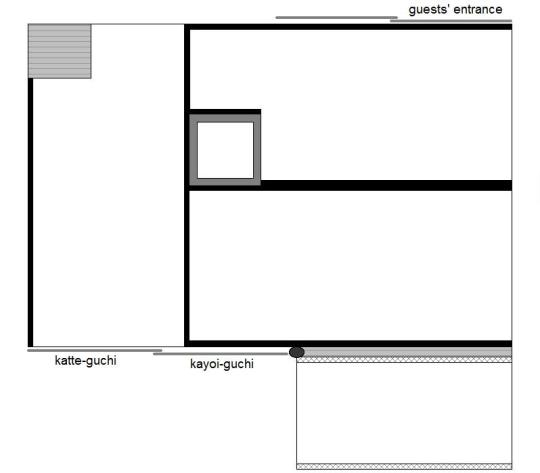
Because in this room the host faces the guests (albeit on a diagonal), it seems to create a feeling of intimacy which his 2-mat rooms may have lacked (since there is no real chance for eye-contact during most of their time together), Rikyū may have borrowed it when he had something important to discuss with his guests.
⁴Daimonji-ya Yōsei [大文字屋養清].
This refers to Daimonji-ya Yōsei [大文字屋榮清; his dates of birth and death are not known], though it appears that Rikyū has written the wrong kanji for “yō” [養, as opposed to 榮]*. He was an important machi-shū-chajin who had relocated his family from Sakai to Kyōto. The house was famously known to have been the owner of the Hatsu-hana katatsuki [初花肩衝], which Yōsei’s father presented to Oda Nobunaga in 1569. They also owned one of the most famous bokuseki written by the Song period Chán monk Xūtáng Zhìyú [虛堂智愚; 1185 ~ 1269] (pronounced Kidō Chigu in Japanese), which was therefore known as the Daimonji-ya Kidō [大文字屋虛堂]*. ___________ *This scroll is usually known as the yabure Kidō [破れ虛堂] -- “torn Kidō” -- today. This sobriquet derives from an episode that occurred later in the scroll’s history, when it was damaged (in the early Edo period, circa 1637) by an apprentice who worked in the Daimonji-ya establishment.

The scroll was very carefully repaired, and the damage is not apparent when the scroll is viewed from the usual distance.
⁵Onaji Sōshun [同 宗春].
This person has not been identified, though he was perhaps a younger brother of Daimonji-ya Yōsei*. As the family owned a number of very famous -- and enormously expensive -- tea utensils, it was likely that all of the sons cultivated an interest in chanoyu.
This is the only instance where Sōshun is mentioned in Rikyū's surviving kaiki. ___________ *Onaji [同] is not a surname -- as the various Japanese commentators suggest. It means that the surname is the same as for the previous guest -- this kaiki contains many abbreviations of this sort, because it was intended for no eyes but Rikyū’s.
⁶Sho [初].
The shoza.
In terms of kane-wari, the shoza was arranged as follows:
- the kakemono was displayed in the tokonoma by itself, so the toko was han [半];
- the kama was placed in the ro, making the room han [半] as well;
- and the go-sun-hane and kan were arranged side by side on the tsuri-dana, making it chō [調].
Han + han + chō is chō. This was appropriate because this chakai was taking place in the afternoon.
⁷Tōyo [東與].
This refers to a bokuseki written by the Yuan period Chán monk Dōnglíng Yǒng-yú [東陵永璵; 1285 ~ 1365]* (whose name is pronounced Tōryō Eiyo in Japanese).

Dōnglíng Yǒng-yú is said to have been related to the great Chán master Wúxué Zǔyuán [無學祖元; 1226年 ~ 1286] (Mugaku Sogen in Japanese). Both Wúxué and Dōnglíng emigrated to Japan in order to spread the orthodox Chán teachings.
Dōnglíng Yǒng-yú was a follower of the Sōtō sect [曹洞宗] of Chán; and, as mentioned above, he came to Japan in Shōhei 6 [正平六年] (1351). Although he was a monk of the Sōtō Shū, he served as the abbot (jūji [住持]) of a number of important Japanese temples that had no affiliation with that sect, among which were the Tenryū-ji [天龍寺] and Nanzen-ji [南禪寺] in Kyōto, and the Kenchō-ji [建長寺] and Enkaku-ji [圓覺寺] in Kamakura. __________ *When writing this abbreviated version of his name (it uses the first and last of the four kanji), Rikyū has mistaken the second kanji -- writing yo [與], rather than yo [璵]. The first of these was, of course, the first syllable of Rikyū’s own childhood name (Yoshirō [與四郎]), and this may be the reason for his error.
⁸Kama arare [釜 アラレ].
This was Rikyū's ko-arare uba-guchi kama, made by Yoshirō, the kama-shi who appears to have returned with Rikyū from Korea.
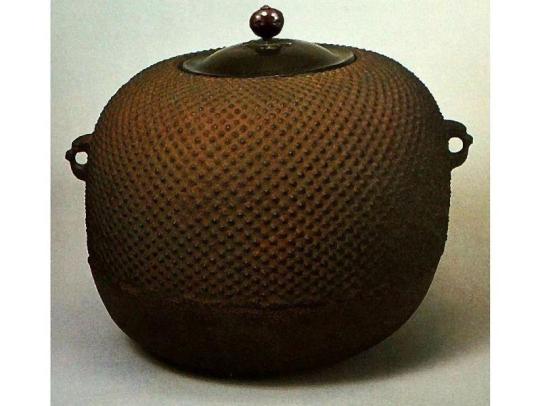
⁹Tana ni kan ・ habōki [棚ニ 鏆 ・ 羽帚].
The kan and habōki (a go-sun-hane [五寸羽]) were arranged side by side on the tsuri-dana.

The rule was that the habōki should always be closest to the wall when arranged in this way.
¹⁰Shiru ko-kabu ・ tairagi [汁 小カブ ・ タイラキ].
This was probably a clear soup (the turnip roots and scallops were boiled in ni-ban dashi, with the chopped leaves of the turnips added shortly before the soup was served so they would be crisp).
Ko-kabu [小蕪] are, as stated above, immature turnips*, both the leaves and roots of which were included in the soup.
Tairagi [たいらぎ = 玉珧] is commonly known as the Japanese scallop or comb pen-shell†. It is the kai-bashira [貝柱] (the muscle that opens and closes the shells) of this mollusk that is eaten. The scallops were cooked by being boiled in the broth in which they would be served. __________ *Turnips were among the various brasscaceous plants usually grown in the kitchen garden as a source of fresh greens during the winter and early spring.
†Atrina pectinata.
¹¹Tai ko-tsuki [鯛 子付].
Tai [鯛] is the sea bream. Ko-tsuki [子付] means that the tai contained eggs -- which were considered a special delicacy.
While it is possible to grill the tai*, it seems that, more commonly, a sea bream that is gravid with eggs is cut into large pieces and boiled in flavored broth, or possibly steamed (either of which methods of cooking solidifies the egg mass so that it can be sliced). Thus, the tai was more likely a sort of ni-mono course. __________ *And Kumakura Isao states unequivocally that the tai ko-tsuki was the yaki-mono. However, it must be understood that he is trying to interpret the kaiki in the Nampō Roku through the medium of 20th century Urasenke practices, and this highly regimented form is not really applicable to the nature of Rikyū's kaiseki.
¹²Kuro-me [黒メ].
Kuro-me [黒布], as has been mentioned before, is a type of seaweed that is eaten during the colder months. It somewhat resembles kelp, though it is a dark brown-black in color (hence the name, which means “black cloth”), rather than green. Kuro-me was usually served raw, dressed with a mixture of rice vinegar, sesame oil, soy sauce (or, perhaps, iri-zake), sugar, salt, and ginger juice.
¹³Ae-mono [アヘ物].
Ae-mono [和え物] is a salad-like dish, containing julienned vegetables (and sometimes fruits or fruit rind -- skin of the yuzu seems to have been popular during Rikyū's period), and occasionally finely sliced raw fish as well, all of which would be mixed together with a rice-vinegar-based dressing.
¹⁴Kashi iri-kaya ・ shiitake [菓子 イリカヤ ・ 椎茸].
Iri-kaya are the nuts of the Japanese allspice tree (Torreya nucifera)* that have been roasted (iri [煎り]) in a shallow pan over a charcoal fire.
Shiitake [椎茸] mushrooms, when being prepared for use as a kashi, are lightly salted while they are grilled on skewers over charcoal. __________ *The kaya [榧] is also known as the Japanese nutmeg-yew. It is a coniferous tree in the family Taxaceae, in which the true yews (which the kaya resembles in its foliage) are also found. The seeds of the true yews (Taxus spp.) are toxic to humans -- as are all parts of the plant except for the fleshy aril (which surrounds the seed).
¹⁵Go [後].
This notation is missing from the Enkaku-ji version of the kaiki. From this point begins the description of the goza.
With respect to the kane-wari:
- the tokonoma contained the chabana, arranged in a bamboo hanaire that ws suspended on the back wall, and so was han [半];
- the room held the kama and the mizusashi, upon which was placed the hishaku, and with the futaoki standing in front of it (squarely placed on the kane), and so was chō [調];
- and the tea container -- a small natsume -- was placed in the center of the shelf, which removed it from contact with the kane, and so the tana was chō [調].
Han + chō + chō is han, which is correct for the goza of a gathering that is held during the daytime.
¹⁶Kago ni me-yanagi [籠ニ メ柳].
The basket was most likely Rikyū's Katsura-kawa kago [桂川籠], which would have been hung on the hook attached to the back wall of the tokonoma.

The flower was a budding branch of the weeping willow (me-yanagi [目柳 or 芽柳]*), arranged so that it arched toward the temae-za. While it is possible that the branch actually had willow flowers on it, more likely the "buds" were leaf buds -- to show the arrival of early spring. __________ *This expression is an abbreviation. In full, it is me-bari-yanagi [目張り柳] -- which means a branch of weeping willow with the (leaf) buds starting to expand.
¹⁷Tana ni chaire ko-natsume [棚ニ 茶入 小ナツメ].
This would have been an ordinary black-lacquered small natsume*, tied either in a shifuku or in a small purple-dyed furoshiki (the model for the modern-day temae-fukusa).

__________ *Tanaka Senshō -- apparently, in an effort to make the kane-wari come out as he wants it to -- decided that, in this entry in the kaiki (and unlike all other instances where Rikyū used the same formula), chaire ko-natsume [茶入 小ナツメ] means that Rikyū arranged both a chaire (of what sort it is impossible to imagine -- and Tanaka gives no hint of what he was thinking it might have been) and a ko-natsume (the latter for usucha -- which would also have been contrary to Rikyū’s usual practices) on the shelf: an argument which Kumakura Isao rather mindlessly apes in his interpretation of this chakai.
Shibayama Fugen argues (contrary to the way the kaiki is formatted) that the tana held not only the natsume, but also the futaoki and hishaku (which would hardly be treating the futaoki appropriately: but at least he interprets “chaire ko-natsume” to mean that “the chaire [was a] ko-natsume” as is consistent with Rikyū’s usual usage).
As I wrote earlier in this blog, I am of the opinion that the tsuri-dana -- as a direct derivative of the naka-dana of the fukuro-dana -- should partake of the fukuro-dana’s 7-kane system (even though the utensil mat, as a kyōma-datami, itself uses the 5-kane system). In such a case, displaying the ko-natsume in the center of the tana disassociates it from either of the kane that cross the shelf, thus making it chō [調] (the ko-natsume is 1-sun 9-bu in diameter), as can be seen in the sketch that follows footnote 19, below.
¹⁸Mizusashi Seto [水指セト].
This was Rikyū's Seto mizusashi, that had been made to Jōō's specifications (and originally intended for use on the fukuro-dana).

¹⁹Hishaku [ヒシヤク].
The hishaku was placed on top of the mizusashi, to lock its lid, with the handle extending toward the right -- as shown in the sketch of the utensil mat, below.

²⁰Futaoki Rinzai [蓋置臨濟].
This was the bronze name-seal that had been made for the great Chán monk Línjì Yìxuán [臨濟 義玄; ? ~ 866], on the orders of the Emperor of China. In the Enkaku-ji version of the text, this entry is marked with a red spot (shown here by a “﹆“ mark), to indicate that this is the “special utensil” that was used during this chakai.
This futaoki had originally belonged to Nōami [能阿弥; 1397 ~ 1471], and it was he that first used it as a futaoki -- and who laid down the rules for its use. This futaoki has not been mentioned since the early Edo period, and its whereabouts are not known.
Rikyū may well have determined the tori-awase for this chakai based on a desire to use this very special futaoki (given the great treasures associated with the Daimonji-ya house, the guests would probably have been disappointed had Rikyū used only ordinary things during this gathering), and his handling of it was intended to draw their attention to it*.
While Tanaka Senshō suggests that the Rinzai futaoki was placed on the left side of the mat, with the hishaku resting on it (and the handle of the hishaku parallel to the heri -- as is often done at the end of a temae), the arrangement shown in the sketch (above), with the futaoki squarely on the kane, seems more likely -- since it would afford the guests the chance to look at this precious futaoki when they entered the room for the goza. During the goza of this chakai, the futaoki was decidedly the highlight of the za, so Rikyū certainly would have displayed it in a way that called attention to its presence. ___________ *Displaying it by itself in the middle of the mat, as an hitotsu-mono [一つ物] (this expression -- which will be explained more fully in Book Six of the Nampō Roku -- means a meibutsu utensil that is displayed squarely on its kane, in order to call special emphasis to its special ranking) would have been inappropriate, since this object is merely the futaoki, not the chaire or chawan.
Nevertheless, it may have been because of the way that Rikyū arranged the futaoki that a small natsume was used, one that would fit between the kane when placed in the middle of the shelf.
²¹Su [ス].
The things mentioned after this notation were brought out from the katte at the beginning of the temae.
²²Chawan Mishima [茶碗三嶋].
This was Rikyū's Mishima chawan, which he seems to have brought back from Korea.
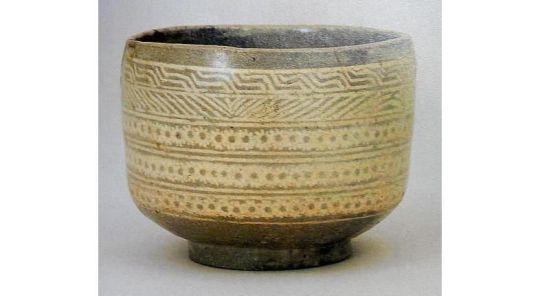
This bowl was originally made as an ordinary rice bowl.

Arranged in the chawan were the chakin, chasen, and a ori-tame [折撓] of Rikyū's own making (above -- though the chashaku is not actually mentioned in the kaiki), as usual.
²³Mentsu no uchi ni irete hakobu [メンツノ内ニ入テハコフ].
The chawan (containing the chakin, chasen, and chashaku) was placed inside a mentsū [面桶], and in this way all of these things were brought into the room in a single trip.
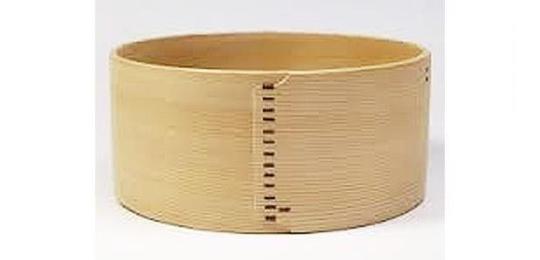
Since it was a rule that the host should minimize the number of trips between the utensil mat and the katte when serving tea in the small room -- and this idea seems to have included how many times he turned back from the temae-za to the katte-guchi -- placing the chawan inside the mentsū (which was always brand new) made the beginning of the temae simpler.
0 notes
Text
Turkey’s shell-shocked opposition struggles to find a way forward
Ankara, Turkey (CNN)Turkish citizens who did not want to give more powers to President Recep Tayyip Erdogan had a very hard Monday.
There was quiet discontent in Ankara, as if its pockets of opposition had been zipped tight.
Duysen Talas, a 28-year-old born in the capital, Ankara, was slouched over in a chair of the pro-Kurdish opposition party Peoples’ Democratic Party (HDP) headquarters.
Talas, like many of the country’s 24 million “No” voters, woke up in a post-referendum haze — looking for answers to a referendum tainted by complaints during the campaign, the voting and preliminary results.
Erdogan declared victory on Sunday night after state-run media Anadolu reported 51.4% voted for his “Yes” campaign.
The razor-thin majority of votes had opponents crying fraud and saying the “Yes” side would not have had so many votes and even could have lost, if the Turkish Supreme Board of Elections had followed its own protocol.
Even as the ballots were being counted on Sunday, the board decided to allow unstamped ballots to pass as legal votes — a move that the opposition says gave the green light to voter fraud.
Tana de Zulueta, head of the Organization for Security and Cooperation in Europe and the Council for Europe election monitoring group said the decision “significantly changed the ballot validity criteria, undermining an important safeguard and contradicting the law,” amongst other campaign concerns.
Challenges to the result may come, but the there is no indication that it will not stand.
As pro-Erdogan supporters flooded Ankara’s streets in celebration last night, many opposition voices in the country’s capital remained quiet — fearful, perhaps of state-led retribution that’s not held back with force or arrests against dissident voices since July 2016 when a failed coup rocked the country and at least 249 people died in a chaotic night of violence.
At HDP headquarters, Talas, who lives in Austria but had flown to Turkey for the referendum result, told CNN he “was expecting this fraud.”
Turkey’s referendum: One thing to know
Replay
More Videos …
MUST WATCH
He’d headed to the opposition offices to find out what demonstrations were planned, but didn’t get the answer he was looking for.
Upstairs, HDP member of parliament and party spokesperson Osman Baydemir could not see beyond the result.
He recapped an unfair campaign in the lead up to the vote, a perception that the election monitors corroborated at a press conference in Ankara on Monday.
Related: How Erdogan transformed Turkey’s democracy
During the campaign, rallies and the official HDP campaign song were forbidden. Supporters were subject to state-led surveillance, and MPs and leaders were jailed without trial, Baydemir said.
In this stark political landscape, Erdogan accused the party of supporting terrorist group PKK and jailed 5,000 of their supporters — including leaders Selahattin Demirtas and Figen Yuksekdag.
Demonstrating is not seen as an option for now. Instead, they — along with main opposition Republican People’s Party (CHP) — will file their objections, demanding a recount of at least 37% of the votes.
“We are going to make our official rejections of the vote count, but we don’t think it’s going to make a difference,” Baydemir said.
Foti Benlisoy, historian and writer of “Gezi Uprisal: The Interesting Beginning of Turkey” told CNN that it’s no surprise that the political actors are staying away from demanding action in a climate of fear.
Some protests, seen in Istanbul and Izmir on Sunday and Monday “are mostly coming from those people who have been working in their neighborhood’s ‘No’ committees; the young people who have worked for “No’ and believed that the result would be ‘No,'” he said.
It is hard to say if these protests would spread to other cities, such as Ankara — or if they would continue, he said.
Talas, who also would visit main opposition party CHP headquarters and was considering staying in Turkey to demonstrate, said he understood why the opposition wasn’t planning action for fear of violence — or in the worst case — death, but that perhaps a show of solidarity could change that.
As Erdogan spoke at Ankara airport to supporters who cheered the backing of the President’s proposal to bring back capital punishment, across town from the HDP offices at a cafe in a left-leaning university block, people sat in a leafy garden under a grey cloud.
Yasin K., a vegan cook, was drinking beer with two friends. He explained that the resistance would be a slow burner.
“We’re in a strange position where we haven’t reached the boiling point quite yet.”
Yasin pointed to the “No” vote in Antalya — a traditional pro-Erdogan stronghold.
The tourist town has suffered economic losses as a result of the country’s deteriorating relations with Russia — a country that provides the area with one of its main sources of income — as well as a string of terror attacks that have made the country less desirable for holidaymakers.
Yasin predicted Erdogan would continue to make enemies abroad and that would continue to hurt Turkish people.
“The boiling point is going to be about the economy — and it’s coming. And that’s going to be the end of Erdogan and AKP,” he said.
Related: What comes next for Turkey?
Merve Semerci, a 32-year-old art student came to discuss the results with her two friends who drank beers while they spoke of the “depressing” ballot controversy.
Although she “definitely thinks there was fraud,” the slim margin between votes strengthened her resolve for a growing opposition.
“I don’t think that people will continue to be silent against this high-pressure environment — the oppressed will find the power in themselves again. But this time we will be moving slower and more calmly because of the experience we gained during and after the (Gezi) protests.”
“Of course now our motivation and energy has taken a blow. But instead of going out to the streets right now, we have to find ways to renew ourselves and come together — to give each other hope. We do feel oppressed right now but we know that we have to move strategically as well,” she said.
Back at HDP headquarters, MP Baydemir offered a glimmer of optimism.
“Despite all these pressure politics, we’ve gained hope,” he said.
“There are millions of people in this country that are against one man — and they want justice,” he said.
Later that evening, the Turkish Council of Ministers signed the decision to extend the state of emergency — signed into place by Erdogan nearly nine months ago — for an additional three months.
Read more: http://ift.tt/2pbluyQ
from Viral News HQ http://ift.tt/2pM7M1R via Viral News HQ
0 notes